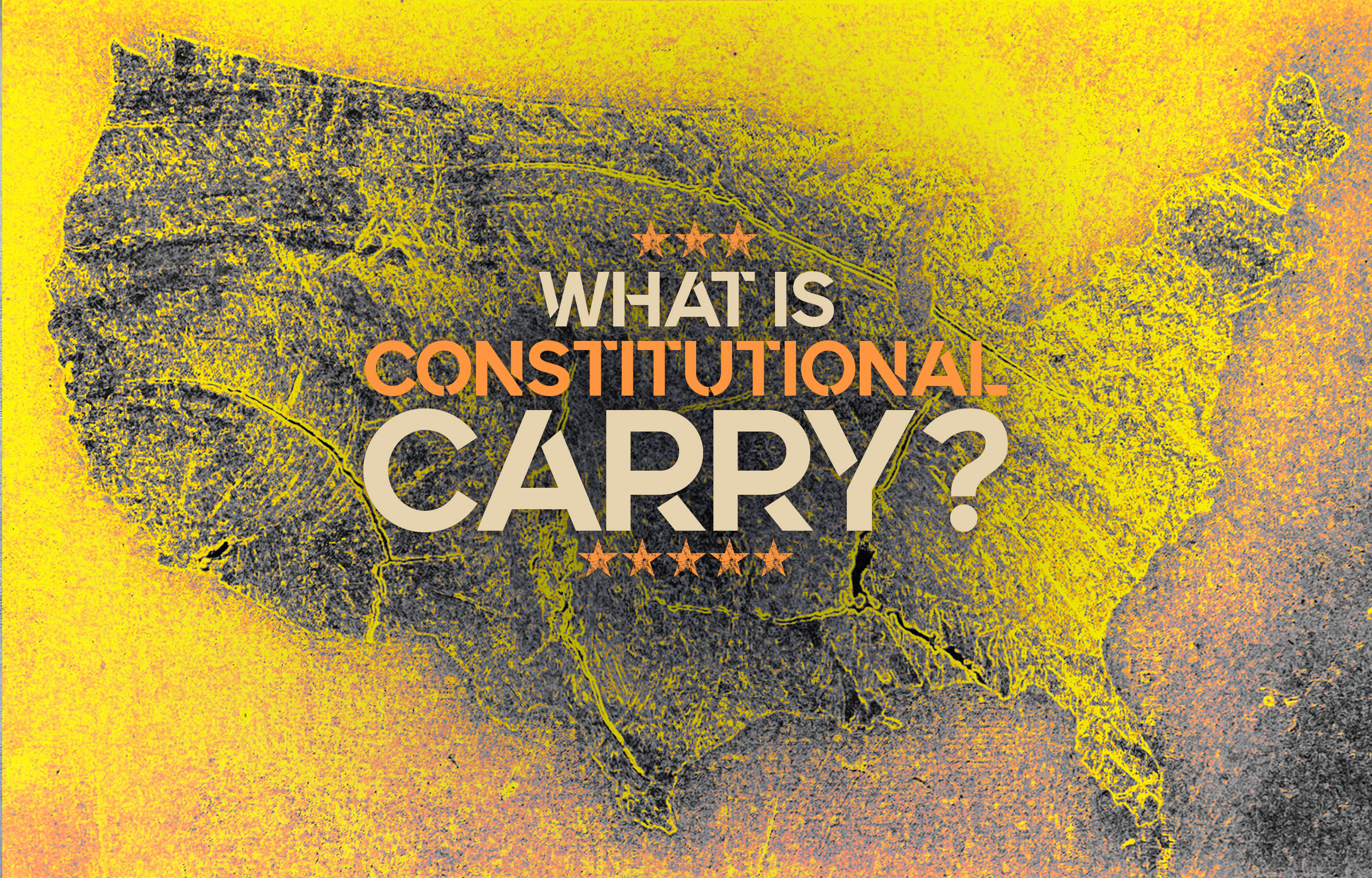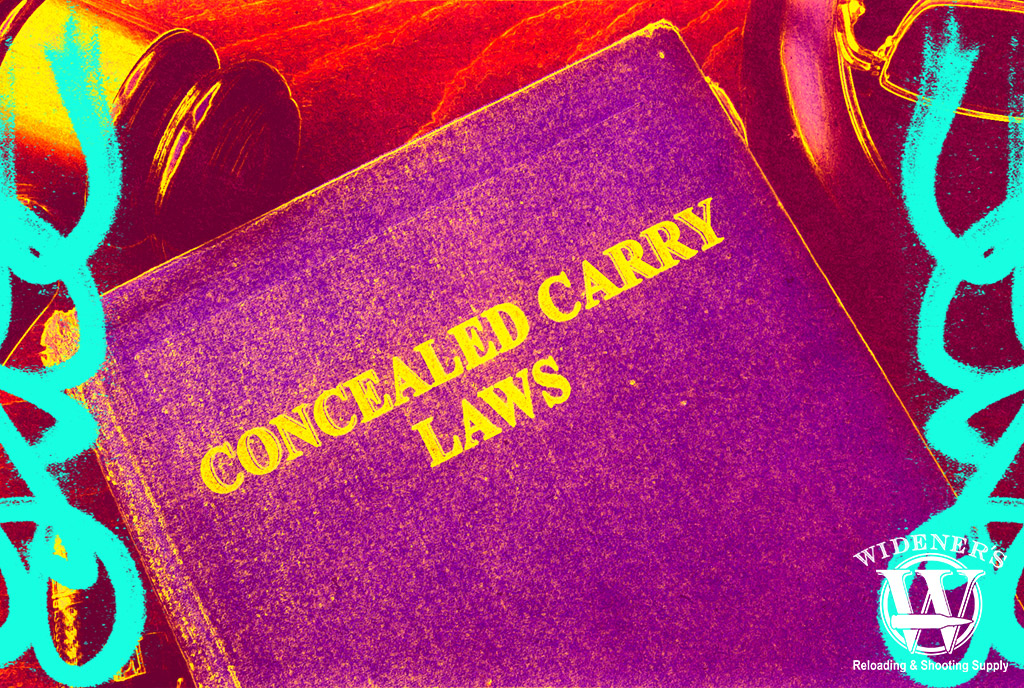

By Guy J. Sagi
The Second Amendment consists of 27 words, ending with, “…the right of the people to Keep and Bear Arms, shall not be infringed.” The concept was radical in an era dominated by monarchs and dictators. Armed citizenry threatened the ability to maintain reign over defenseless servants. The principle is a cornerstone in our democracy, played a central role in its survival, and continues to stand guard over our freedoms.
Despite those facts, gun rights have slowly eroded in the past 200 years. Constitutional carry laws in 27 states—so far—have reclaimed a common-sense chunk of that substance. But what is constitutional carry?
Definition Of Constitutional Carry

Constitutional carry gives law-abiding residents of legal age the ability to carry a gun, open or concealed, without a permit.
In its purest form, constitutional carry allows law-abiding residents of legal age to carry a gun, open or concealed, without applying for and acquiring written permission from the government. However, regional politics, geography, and other factors often steer states into adopting something slightly different.
Some state constitutional carry laws allow residents to carry concealed without a permit, but the statute does not extend to non-residents. North Dakota, for example, requires living in the state for at least a month before lawfully carrying concealed without a permit.
Qualification age varies, too. In West Virginia, you need to be 21. However, if you’re an active member of the U.S. military, National Guard, or reserves, you can do so at 18. It’s 18 years old or older in Indiana, and you can carry concealed or openly—your choice. The magic number in Florida is 21, and the law requires the gun to remain unseen and under concealment.
Modifications are common—so the above numbers may have already changed—and local, state, and federal regulations often preclude the practice in certain establishments and offices. Despite the variations, each constitutional carry law has regained solid ground in gun rights. Exercising them lawfully, however, requires knowing the rules in your region and in those states you visit that have enacted the law.
The fluidity and variants defy a blanket definition, although every constitutional carry law acknowledges law-abiding citizens have the right to self-defense, even when they leave home. That’s where it shines brightest, too.
What Are The Advantages?

The number of bureaucratic restrictions placed on legal gun owners in the United States grows every year.
Words are scarce enough in the Second Amendment to make legal and political misinterpretation a formidable—hopefully impossible—task. That’s not to say there’s a shortage of contestants in that game show, and they’ve found measures of success around the edges.
Our Forefathers never envisioned restrictions like waiting periods, capacity limits, tax stamps, etc. Neither did they foresee an ATF that bends like a willow in every political breeze. constitutional carry, in its various forms, takes back a chunk of that real estate, harnessing a common-sense approach to eliminate unnecessary, potentially dangerous self-defense hurdles.
Simplified Firearm Possession
With constitutional carry, law-abiding citizens of legal age who own an appropriate firearm can carry it outside their home without burdensome delays or fees. They are still required to follow local, regional, and federal regulations when doing so.
Procuring a concealed carry permit has significant advantages, but not everyone can attend a certified course. There are various reasons, including physical challenges, family obligations, school schedules, and others. The biggest is long work hours to make ends meet.
Economic Factors
Today’s inflationary economy explains why it affects so many at higher risk of becoming victims. Working 8 a.m. to 5 p.m., Monday through Friday, is a reality for those struggling to meet family bills. Overtime hours, including weekends, are a welcome financial friend.
Finding a state-certified concealed carry course that meets in the evenings is tough, even impossible in some areas. The gun owner could always take time off work to attend daytime sessions, but that’s a double-edged sword. Instruction isn’t free, and time away from their job surrenders wages.
Time & Availability
That’s not the only consideration, either. After passing the course, they must submit the application in person at their local chief law enforcement office. There, administrative staff perform various tasks, usually fingerprinting, ID verification, and, of course, collection of another fee. Those buildings are only open Monday through Friday, from 8 a.m. to 5 p.m. That’s more time away from the job, and it’s déjà vu all over again—sans fee—when it’s time off to pick up the permit if approved.
Streamlining Access to Self-Defense
Constitutional carry strips away the red tape, burdensome fees, and the requirement that an elected official grant permission to carry to defend yourself and your loved ones. It eliminates the financial- and work-related strain. The advantages are huge for those caught in the grips of a shaky economy—the exact demographic that can’t afford to live in a statistically safer suburb.
Roadblocks, cost, and bureaucratic permission slips are not what the Forefathers envisioned for law-abiding citizens when they crafted the right to Keep and Bear Arms. Constitutional carry eliminates those hurdles in the 27 states that currently recognize it, although it also brings some potential problems.
Constitutional Carry Concerns
Quality concealed carry courses invest a lot of time on legal matters — and for good reason. When you’re allowed to draw and fire a concealed handgun without violating the law varies by state and can carry the prerequisite of attempting to escape or retreat from the felonious assault. So-called stand-your-ground laws mitigate the latter requirement in some regions but not all.
The gray area before physical contact also gets cloudy. In some states, for example, it’s considered brandishing if you show or mention you have a gun—whether to defuse an angry confrontation before it escalates or show it off in public. It can lead to citations or arrest just for opening your concealing coat or touching the pistol grip.
Law enforcement usually understands when the owner feels a genuine threat, adheres to gun safety rules, and applies common sense. The court doesn’t witness the same first-hand violence as those who protect and serve, so don’t expect the same empathy there.
Criticism of Constitutional Carry

All responsible gun owners should know the basic gun safety rules, and seek training to improve their skills.
Critics often claim that those who practice constitutional carry lack the legal knowledge provided by quality concealed carry courses. That doesn’t prevent them from learning it. Themselves. Judging by the lack of incidents. it looks like they’re a studious group.
If you’re among those exercising that right, find and heed expert advice online, inquire at the range, or ask your local law enforcement agency for guidance. Do not subscribe to urban myths, like hauling the attacker’s body inside the house after you’ve shot him. Know the current regulations for your region and those you visit.
Ammo Choice
Another concern often voiced about those who carry without a permit is their choice of carry ammo. A shooter owns every bullet they launch, and it’s their responsibility to send it accurately and responsibly. That’s tough under stress, but it all begins at home. Select a load that maximizes the chances of that bullet coming to a stop in the perpetrator.
That kind of terminal performance ends attacks more quickly. It also minimizes the chances the projectile will pass through and needlessly put innocent bystanders at risk. Know why full metal jackets are great for practice but the wrong choice out on the mean streets or even apartments. The Widener’s blog is a great place to start research if you haven’t already done so. Our hollow point vs. full metal jacket bullet blog is a great reference.
History Of Constitutional Carry
Vermont was the first constitutional carry state, allowing law-abiding citizens to carry open or concealed since the late 1700s. It stood alone in that position for more than 200 years. In 2003, Alaska was the second to adopt a similar law.
Today there are 27 members of the club. They are Alabama, Alaska, Arizona, Arkansas, Florida, Idaho, Indiana, Georgia, Iowa, Kansas, Kentucky, Maine, Mississippi, Missouri, Montana, Nebraska, New Hampshire, North Dakota, Ohio, Oklahoma, South Dakota, Tennessee, Texas, Utah, Vermont, West Virginia, and Wyoming. South Carolina’s legislature resumes a constitutional carry measure debate early in 2024.
As more and more states recognized the right to self-defense without a government permission slip, some felt concealed carry permit numbers would plummet. Even now, with more than half the nation recognizing constitutional carry, those predictions are wrong.
John Lott, president and founder of the Crime Prevention Research Center, monitors the figures closely. In his November 2022 report, he wrote, “As the United States is moving into a post-pandemic era, the number of concealed handgun permits has continued increasing. The figure now stands at 22.01 million—a 2.3% increase since last year.”
Permit Reciprocity Between States
The ability to carry in a state with reciprocity is the biggest reason there’s been no decline in permit numbers. The streamlined process when purchasing a firearm in some regions is a bonus. Permit holders voluntarily undergo the FBI’s National Instant Criminal Background System (NICS) check to secure the license, and their law-abiding lifestyle is re-checked often. Rather than force the permittee to endure a redundant NICS check to buy a gun, in many areas, they simply present their license to the retailer.
There are other advantages, depending on the state of residence. Reaping them, however, requires attending classes and exhibiting knowledge about firearms, and usually displaying proficiency with one at the firing line. There are also the course and application fees, all on top of purchasing a carry firearm and suitable ammunition. Completing the process is not fast or free.
On the other hand, constitutional carry is an instant route for law-abiding citizens of legal age to bolster self-defense capabilities. Add some research, add a training course when time and budget allow, and it is effective and fast.
Constitutional Carry States List
A list of states that allow permitless concealed carry, with permit type, and age requirements. Each state sets its own requirements and limitations for carrying firearms. Below is a list of the current constitutional carry states (list updated for 2024).
| State | Carry Type | Min Age |
|---|---|---|
| Alabama | Permitless | 21 |
| Alaska | Permitless | 21 |
| Arizona | Permitless | 21 |
| Arkansas | Permitless | 18 |
| Florida | Permitless | 21 |
| Georiga | Permitless | 18 Military, 21 Civilian |
| Idaho | Permitless | 18 |
| Indiana | Permitless | 18 |
| Iowa | Permitless | 21 |
| Kansas | Permitless | 21 |
| Kentucky | Permitless | 21 |
| Maine | Permits Recognized | 21 |
| Mississippi | Permitless | 21 |
| Missouri | Permitless | 18 Military, 19 Civilian |
| Montana | Permitless | 18 |
| Nebraska | Permitless | 21 |
| New Hampshire | Permitless | 18 |
| North Dakota | Permitless | 18 |
| Ohio | Permitless | 21 |
| Oklahoma | Permitless | 18 Military, 21 Civilian |
| South Dakota | Permitless | 18 |
| Tennessee | Permitless | 18 |
| Texas | Permitless | 21 |
| Utah | Permitless | 21 |
| Vermont | Permitless | 18 |
| West Virginia | Permitless | 21 |
| Wyoming | Permitless | 21 |
Why Constitutional Carry?

Constitutional carry acknowledges a law-abiding citizen’s right to defend themselves and their loved ones.
There are some drawbacks, with the lack of formal education cited most often by critics. Judging by the lack of incidents and scattered criminal encounter reports, practitioners appear to be a studious group.
The advantages include delivering a message criminals understand. Constitutional carry acknowledges a law-abiding citizen’s right to defend themselves and loved ones with a firearm does not end when they step outside their doorstep, and doing so does not require a bureaucratic permission slip. It applies to all law-abiding citizens of legal age, regardless of race, creed, political clout, sex, or financial situation.
There’s a decided advantage when it’s difficult for perpetrators to identify their next easy victim.


